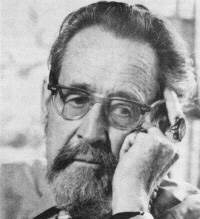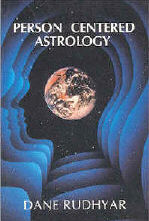 |
| Home | Bio | Art | Music | Literature | Civilization & Culture | Philosophy of Wholeness | Theosophy & Spirituality | Astrology |
 Dane Rudhyar
New York, 1968.
Part 1. 1895-1916
Part 2. 1917-1919 Part 3. 1920-1924 Part 4. 1925-1929 Part 5. 1930-1936 Part 6. 1937-1944 Part 7. 1945-1954 Part 8. 1955-1967 Part 9. 1968-1971 Part 10. 1971-1974 Part 11. 1975-1985 Giants have always walked the earth, those children of the Cosmos whose flame lights the way for lesser men. Today is no exception. Rudhyar’s growing legacy to questing and aspiring humankind, at a time when his unique capacities speak with clarity and direction to the needs and hopes of an age in transition, has, in his own lifespan, enriched the Planetary Soul. In the course of his years, productive and integrated beyond measure, he has offered his love and wisdom, whenever the door was open, and in his massive wake the countless seeds thus sown have quickened the race with mental and spiritual plenitude. How better to pay tribute to this friend of Man than in his own visionary prose: he is " . . . one of the many agents of the Power of Evolution, of the cyclic Rhythm of universal existence. He acts in time and space, completely available to meet the need of his society and his environment as a transforming force, as a 'mutant' rather than a 'mystic.'"
Robert Bainbridge, Ph.D.
Prof. of Comparative Religion Calif. Institute of Asian Studies Working prolifically for over five decades, every aspect of Rudhyar’s work bears the imprint, the generating impulse of the seed. His earlier writings such as Art as Release of Power, contains a vision of the need that encompasses an understanding of the magical role of art in the cycle of civilizational growth and decay. His brilliant work in astrology which began with The Astrology of Personality carries his conception of the seed and the cyclic rhythm of the whole through intricate levels of cosmic and psychological perception. The natural outcome of his work could only be a book like The Planetarization of Consciousness, for in the totality of Rudhyar’s life endeavor there is a unique circuitry. Beginning with art as the primary expression of the wholeness of human being, Rudhyar was naturally led to a consideration of the relation between the harmony of the human organism and that of the greater environment in which we are evolving. In his search not only to understand, but to express as well, his intuitions concerning human and cosmic harmony, Rudhyar has articulated as few others have done what may well be some of the basic premises of an entirely new – and planetary – cycle of human experience.
Jose and Miriam Arguelles
Authors and Artists |

Part Nine Sudden Popularity: 1968-1971
In 1968 Birth Patterns for a New Humanity (later reisssued by Harper and Row under the title Astrological Timing — The Transition To The New Age) was written, typeset by Tana, and published by Servire in Holland. During this year many talks were given around Los Angeles and in the San Francisco area, bringing important connections to Rudhyar with the Bay Area, with the Esalen Institute, with Sam Bercholz, founder of the Shambala Publications in Berkeley, and with friends and associates such as Michael R. Meyer, Jose Arguelles and others. In August Rudhyar addressed the Seattle Biennial Convention of the American Federation of Astrologers, where he received a standing ovation. In Berkeley and San Francisco Rudhyar came in close contact with the generation of young people were eagerly reading his books, and made many friends.
Thanks to Sam Bercholz, Doubleday and Co., New York, agreed to publish in a paperback edition Rudhyar's first astrological treatise The Astrology of Personality. The demand for the book exceeded all expectations, more than 100,000 copies were quickly sold, literally revolutionizing the astrological world through the thousands of educated young people it brought into the field. No other event during the 20th century had such a far-reaching impact upon astrology and how it is viewed and practiced. During 1969 Rudhyar made several trips to the San Francisco Bay Area, giving seminars in Berkeley, at the Stanford University, in Big Sur for the Esalen Institute and in Los Angeles for the Conference on Science and Religion, founded in 1957 by Leland Stewart, and of which Rudhyar was the President for one year. He gave also a series of lectures in Tucson, Arizona for the Gayatra Center, started by his friend Paul Barkley. A number of long articles were also written for several magazines, Horoscope, Astroview, Occult and Omen. In February 1969 Rudhyar was prompted to initiate the International Committee for a Humanistic Astrology "in order to give more publicity to the possibility of approaching astrology and using birth-charts in a way different from both the fortune-telling variety, and the new and spreading ‘scientific’ endeavors to make astrology respectable and teachable in universities." In humanistic astrology Rudhyar attempted to show that there are at least two basic approaches to astrology: "Event-oriented" and "person-centered." He presented astrology "as a kind of Western yoga or psychosynthesis, and the birth-chart as a mandala, a formula of integration for the purpose of ‘making whole.‘" These ideas were developed in six booklets which were later combined into a book entitled Person-Centered Astrology. The Humanistic Astrology Revolution 
In his foreword to Person-Centered Astrology, Rudhyar states "this book came out of an initiative which I took during the evening of February 26, 1969, when I decided. to start the International Committee for Humanistic Astrology. The reason I made this move was that I strongly felt the need to state as clearly and widely as possible that astrology could be given an altogether different meaning. I sensed that today many individuals, especially in the younger generations, while fascinated by astrology, actually were asking for something that the 'scientific,' analytical approach could not given them. They were asking for a way of life in which their relationship as individuals to the universe would be given a constructive meaning. They wanted not so much to know the 'how,' as to realize in a new, cosmic way, the 'why' of their existence. They wanted to be made whole, and to discover how best to achieve this."
Rudhyar goes on to state that his aim in publicizing the humanistic approach "has been to stand against the present de-personalizing trends which augur so badly for our Western civilization, and to place the individual person at the place where it belongs in astrology, i.e., at the center of its concerns. I am concerned with persons, not with a system or a profession — persons who live and struggle toward the actualization of their fullest potential of being NOW." The holistic, humanistic approach to astrology formulated by Rudhyar created a revolution in astrology, bringing to astrology thousands of young, educated people, and attracting the interest of credential people working in the helping professions. In 1970 Rudhyar lectured in Tucson, San Francisco, Woodland, Carmel, Dallas. He addressed an audience of 2,000 at the American Federation of Astrologers in Miami, where he again received a standing ovation. In October he flew to New York for lectures and musical contacts; and he talked to a group in Pennsylvania and in Baltimore before returning home. During the summer in Idyllwild, he wrote We Can Begin Again—Together. In a shorter volume, Directives For New Life, some of the ideas developed in the larger work were condensed. A small booklet, A Seed was also published in San Francisco during Christmas 1971. In 1971 Rudhyar completed The Astrological Houses and a smaller volume Astrological Themes For Meditation. During that year he also began one of his most significant and important astrological works, An Astrological Mandala — The Cycle of Transformation and Its 360 Symbolic Phases, in which he reformulates and discusses the Sabian symbols psychically produced in 1925 through Marc Jones and Elsie Wheeler. Rudhyar passed the summer in Palo Alto, talking to students of the Esalen summer school as well as giving two seminars for the Esalen Institute (in May at Mill Valley with Jose and Miriam Arguelles, on "Education for Rebirth," and in September in Berkeley on "A New Look at H. P. Blavatsky's Secret Doctrine"). He also lectured to students at the University of California in Davis.
Read Part Ten
 Web design and all data, text and graphics appearing on this site are protected by US and International Copyright and are not to be reproduced, distributed, circulated, offered for sale, or given away, in any form, by any means, electronic or conventional. See Notices for full copyright statement and conditions of use. Web design copyright © 2000-2004; by Michael R. Meyer. All Rights Reserved. |
 |